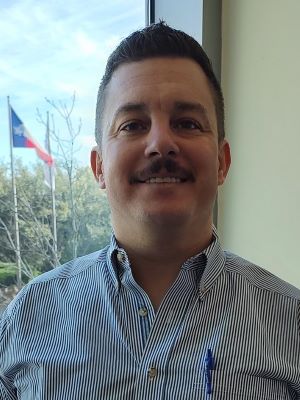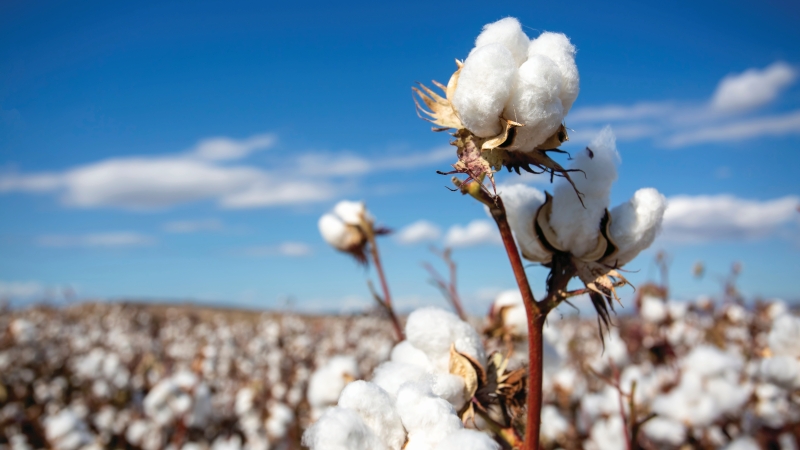Jason Moss Is 2023 Cotton Marketer of the Year
 Jason Moss (Photo: Jim Steadman)
Jason Moss (Photo: Jim Steadman)
Jason Moss farms roughly 8,000 acres in and around Stinnett, in the Texas Panhandle northeast of Amarillo. It can often be a harsh environment for agriculture, described centuries ago by the Spanish conquistador Cortez as not inhabitable by humans.
Fortunately, Cortez had no concept that the area would become a prime production area for row crops and livestock — including cotton. And with his Midwest farming background and years of ag marketing experience, Moss has created a viable, diversified, and successful farming operation that manages to overcome some of Mother Nature’s obstacles to profitably grow more than 2,000 acres of cotton.
That farming experience, combined with his cropping diversification and detailed marketing planning, earned Moss the 2023 Joseph J. O’Neill Cotton Marketer of the Year Award presented by BASF.
“Just a Midwest Grain and Hog Farmer from Illinois”
Moss’ journey from his family’s Midwest farm to Texas cotton producer has a few twists and turns. He hails from Fishhook in West Central Illinois, holds degrees in ag economics from the University of Illinois and Purdue University and an MBA from Indiana University, and has spent more than 15 years in marketing consulting. During a visit with one of his farmer clients in the Panhandle, Moss noticed a nearby farm for sale.
“I saw it as an opportunity to expand out on my own,” he recalls. “It fit my background, and it made sense.”
So, Moss moved his family to Texas and, over the next few years, added a few more farms to the operation. Today, it’s known as Pringle Family Farms, a partnership with a longtime friend Chris Bogner. In addition to the irrigated and dryland cotton acres, the farm includes several thousand acres of corn, dryland wheat, and about 1,000 head of Angus cattle. Moss also still operates the family farm back in Illinois.
He admits that cotton production in the Panhandle can be daunting.
“We’re obviously too far north to grow cotton like the Delta,” he says. “In fact, there are no base acres for cotton north of I-40. It was only when the newer shorter– to mid-season varieties came along that cotton started moving north. We also have more water available than the traditional cotton areas around Lubbock, and that gives us a bit of an advantage.
“When we look at it, our overall per acre cost of production in the Panhandle is a little bit lower than the Delta,” he adds. “We probably put on the same amount of PGRs and weed treatments. But our seed cost is a bit lower, we don’t have the same level of insect pressure, and we’re stripping cotton instead of picking it. We’re on a different grading system and we’re not embarrassed to grow a lower grade because there’s still a good market for it.”
The real challenges come in getting the crop in the ground and establishing a stand without too much interference from the weather.
“We like to plant in early May, and every year our biggest risk time for growing cotton is the first 30 days, because the wind blows all the time,” Moss says. “If we can’t get a good cover established over the winter for strip till and plant into it, we run the risk of seeing the cotton get blown out. We need a good thick, woolly stand of wheat to really protect cotton the way we want. Last year, we found a window and were able to get our cotton planted but ended up losing a third of our crop to hail.
“Cotton insurance premiums for hail are expensive, but it’s rare for us to lose production from another peril besides hail,” he notes. “We typically spend most of our insurance money for hail and not as much for other perils.”
Jason Moss (left) receives the 2023 Joseph J. O’Neill Cotton Marketer of the Year Award from Dr. John Robinson, Texas A&M AgriLife Extension Cotton Economist. (Photo: Jim Steadman)
Marketing Through Diversification
Moss’ experience in ag marketing allows him to practice what he preaches with his own operation. Following a year of declining and stagnant market prices, he puts a plan in place using multiple marketing tools to his advantage.
“I like to diversify and put about a third of our production into a couple of marketing pools, using acre contracts rather than bale contracts,” he says. “We are so far north that we rarely have the heat in August and September to properly finish the crop out. When the heat drops, so does our grade. Last year, we had the highest cotton grade in a decade because the heat was there late in the season.
“But if the quality does bite you, the penalty for an acre contract versus a bale contract is less,” he explains. “We use acre contracts on about two-thirds of our cotton, and I call the price myself.”
Moss starts with an expected price range and projected timeframe, then puts in scale–up orders that he believes are reasonable. As he puts it, the first orders are easier to hit, while the last orders — although doable — may be a little harder to reach.
“I happened to have some in the 89 to –90 cent area that triggered before prices circled back down last year,” he says. “I’ll also hedge on the board. If I can put a floor in with some put options, I always like to do that.”
Add in the crop insurance, and Moss feels confident in his overall marketing coverage.
For 2024, Moss is leaning toward more cotton, putting slightly more than half of their total row crop acres into the crop. Their corn acres will be down for rotation purposes. But there are certainly price risks involved.
“With cotton prices around 80 cents, it’s a little nerve-wracking,” he admits. “That’s our plan right now. But for the best results, I firmly believe if you focus on the decision-making process, the results will follow.”










